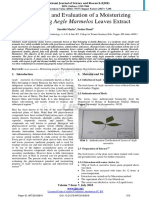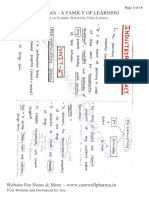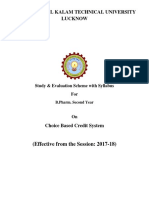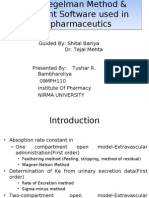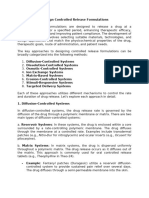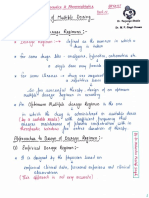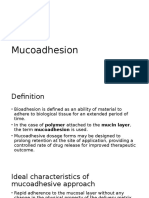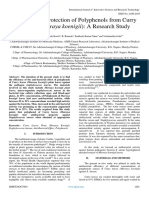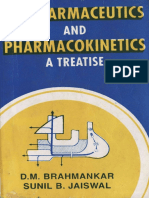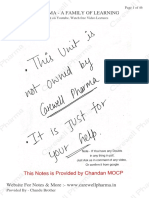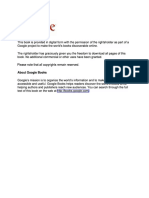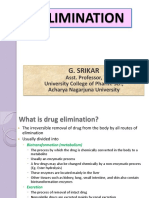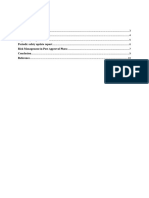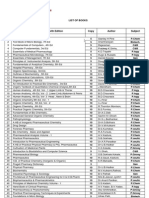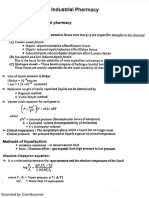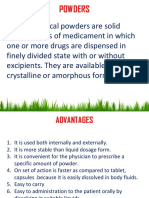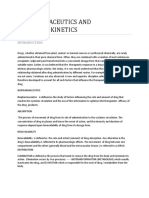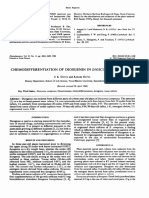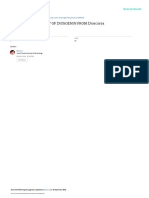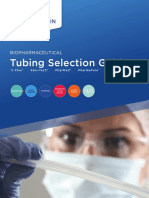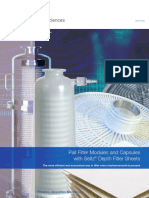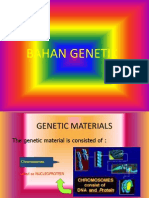Dissolution, Bioavailablllty and Bioequivalence
Dissolution, Bioavailablllty and Bioequivalence
Uploaded by
LuIz ZooZaCopyright:
Available Formats
Dissolution, Bioavailablllty and Bioequivalence
Dissolution, Bioavailablllty and Bioequivalence
Uploaded by
LuIz ZooZaCopyright
Available Formats
Share this document
Did you find this document useful?
Is this content inappropriate?
Copyright:
Available Formats
Dissolution, Bioavailablllty and Bioequivalence
Dissolution, Bioavailablllty and Bioequivalence
Uploaded by
LuIz ZooZaCopyright:
Available Formats
BOOK REVIEWS
Dissolution, Bioavailablllty and Bioequivalence. By Ham& dosage forms such as controlled release drug products and
M. Abdou. Mack Publishing Company: Easton, PA, 1989. topical preparations.
xvii + 554 pp. 26 x 18 cm. ISBN 0-912-734-20-5.$69.95. The section on bioequivalence covers the following topics:
Occasionally a book appears that is informative, instruc- methods for determining bioequivalence of drug products and
tive, well organized, written with clarity, and a pleasure to regulatory aspects; critical issues and aspects relating to
read. Such a book is Dr. Hamed Abdou’s Dissolution, Bio- bioequivalence protocols; in vivo-in vitro correlation studies
availability and Bioequivalence. Dr. Abdou has succeeded in and their value in determining meaningful dissolution limits;
his endeavor to provide a comprehensive, coherent, and and some important case histories of bioinequivalence. Each
competent treatment, in one volume, of the most dynamic of the chapters in the sections on bioavailability and bioequiv-
subject in the pharmaceutical sciences. alence is well written with an extensive and up-todate
Professor John Wagner’s Biopharmaceutics and Relevant bibliography and presents an integrated treatment of the
Pharmacokinetics published in 1971, was the first attempt to subject covered.
cover topics which are the subject matter of this text. Disso- “Understanding the complex and interwoven factors that
lution Technology by Drs. Leeson and Carstensen, published may influence the nature and reproducibility of the biologic
in 1974, was the first monograph on the topic, and surveyed response of pharmaceutical dosage forms is the ultimate goal
the theory and methodology of dissolution, influence of for- of this book,” according to the author. Dr. Abdou has admi-
mulation on dissolution rate, and the biological implications rably succeeded in achieving his goal. In addition, extensive
of in vitro dissolution rate. The twin biopharmaceutical citations throughout the book give the student, as Professor
science areas of dissolution and bioavailability have seen Wagner rightly points out in his foreword, a sense of history
tremendous research activity and growth during the last and acquaintance with contributors to the field.
three decades, and the scientific literature in these areas has This book is essential reading for every pharmaceutical and
grown by leaps and bounds during the last twenty years. Dr. medical scientist engaged in development, testing, and man-
Abdou’s volume makes available for the first time a compre- ufacturing of drug products. It belongs on the bookshelves of
hensive and completely updated text totally devoted to the students and teachers in colleges of pharmacy, and scientists
important (albeit controversial) topics of dissolution, bio- and other professionals in drug regulatory bodies of govern-
availability, and bioequivalence. ment agencies and pharmaceutical industry. Clinical phar-
The book is divided into three sections, each covering one of macologists and other health scientists desirous of learning
the major topics. A little over half the book is devoted to the more about the relationships between drug products and their
section on dissolution. This section includes chapters that clinical performance will find this book a rich and welcome
cover the following topics: principles that control dissolution resource.
of pure drug substances; theories of dissolution; effect of Shrikant V. Dighe
physiochemical properties of the drug on dissolution rate; Division of Bioequivalence
formulation and processing factors affecting dissolution of Food and Drug Administration
solid oral dosage forms; official and nonofficial methods of Rockville, MD 20857
determining the dissolution rate of pharmaceutical dosage
forms; principles and methods of measurement of dissolution
of suspensions, suppositories, topical preparations, transder-
ma1 drug delivery systems, and controlled release dosage
forms; and methods to enhance the dissolution rate of drug
products.
The chapters on formulation and processing factors that
affect dissolution rate of solid oral dosage forms, factors Principles and Methods of Toxicology. Second Edition. Edited
relating to dissolution apparatus, and effect of test parame- by A. Wallace Hayes. Raven Press: New York. 1989. xiii +
ters such as dissolution fluid, agitation, the rate of stirring, 929. 22 x 29 cm. ISBN 0-88167-439-7. $79.00.
additives, and temperature will be found useful and instruc- The second edition of Dr. Hayes’ edited text has maintained
tive by practitioners and students of the art and science of and expanded his concept of producing a teaching reference
dissolution. Chapters on the principles and methods of mea- balanced between the practical and the theoretical. The
surement of dissolution of suspensions, suppositories, topical overall organization of the text has been improved by dividing
preparations, and controlled release delivery systems bring the index into three major sections (Toxicologic Principles,
together a wealth of information that should be of particular Testing Methods, and Specific Organ Systems) and by pro-
interest to those engaged in developing and testing these drug viding each chapter with a chapter-specific outline which the
products. The textual material is clearly presented with reviewer found useful. The new edition contains more tables
numerous graphs and illustrations. Important mathematical and illustrations, making it easier to use than the first
equations are included in the text not to awe or impress the edition. The chapter on acute toxicology still contains the
reader but rather to convey the interrelationships of various section on laws related to toxicology and seems misplaced in
parameters that affect dissolution. The section on dissolution its location. A separate chapter or a combination of the
is perhaps the most attractive and appealing feature of this information on laws and the chapter on the regulatory process
book. All you want to know about dissolution-theory as well would be an improvement.
as practice-is competently and authoritatively discussed. The second edition contains several new chapters, some of
The section on bioavailability discusses the following: which are entirely new, while others result from expanding
principles of pharmacokinetics (compartmental and noncom- first-edition chapters to the point where two chapters are
partmental analysis); mechanisms of drug absorption; justified. The most significant additions deal with clinical
sources of variation in drug blood levels and correlations to pathology, the regulatory process (on of the major motivating
biologic response; methods to measure bioavailability and for forces in toxicology), methods for endomyocardial biopsy, and
enhancement of bioavailability; and bioavailability of special the role of metabolism in toxicology. The chapter on organ
.OO/O
OO22-3549/90//04OO-O377$Ol Journal of Pharmaceutical Sciences I 371
0 1990, American Pharmaceutical Association Vol. 79, No. 4, April 1990
You might also like
- Khanna & Agarwal Physical PharmacyDocument332 pagesKhanna & Agarwal Physical PharmacyMohith KothariNo ratings yet
- Physical Pharmaceutics-Ii: B. Pharm (IV Sem) Physical Pharmacy-II BP 403T Unit - III Coarse DispersionsDocument7 pagesPhysical Pharmaceutics-Ii: B. Pharm (IV Sem) Physical Pharmacy-II BP 403T Unit - III Coarse Dispersionsdipti_sriv0% (1)
- Kombucha Full ReportDocument8 pagesKombucha Full ReportBảoChâuNo ratings yet
- Pharmaceutical Manufacturers ListDocument3 pagesPharmaceutical Manufacturers ListTaylor McBrideNo ratings yet
- Pharmacology- The Molecular Dance: Understanding Drug Interactions: Harmony and Chaos: The Symphony of Drug InteractionsFrom EverandPharmacology- The Molecular Dance: Understanding Drug Interactions: Harmony and Chaos: The Symphony of Drug InteractionsNo ratings yet
- Pharmacogenomics in Clinical TherapeuticsFrom EverandPharmacogenomics in Clinical TherapeuticsLoralie J. LangmanNo ratings yet
- Formulation and Evaluation of A Moisturizing Cream Using Aegle Marmelos Leaves ExtractDocument7 pagesFormulation and Evaluation of A Moisturizing Cream Using Aegle Marmelos Leaves ExtractTaniaNo ratings yet
- Cognosy Unit 5Document50 pagesCognosy Unit 5KanchanNo ratings yet
- PCI D Pharm (Pharmacy Diploma) Syllabus - PharmagangDocument29 pagesPCI D Pharm (Pharmacy Diploma) Syllabus - PharmaganghabeebNo ratings yet
- 4th SEM PCI SYLLABUSDocument20 pages4th SEM PCI SYLLABUSDAMBALE100% (1)
- Methods To Enhance BADocument38 pagesMethods To Enhance BAAamir NawazNo ratings yet
- To Study The Dose Response Curve (DRC) of Acetylcholine Using Frog Rectus Abdominis MuscleDocument15 pagesTo Study The Dose Response Curve (DRC) of Acetylcholine Using Frog Rectus Abdominis MuscleVidhiNo ratings yet
- Gujarat Technological University: B.Pharm Semester: IiiDocument2 pagesGujarat Technological University: B.Pharm Semester: IiiSachin Narkhede100% (2)
- Unit 1 Industrial Pharmacy 1Document16 pagesUnit 1 Industrial Pharmacy 1Krishna PrasadNo ratings yet
- B.Pharm Syallbus As Per AKTUDocument22 pagesB.Pharm Syallbus As Per AKTUShardendu MishraNo ratings yet
- Regulatory IssuesDocument19 pagesRegulatory IssuesSiddhant BanwatNo ratings yet
- Looriegelman and Comp. Application in BiopharmaceuticsDocument22 pagesLooriegelman and Comp. Application in BiopharmaceuticsTushar Bambharoliya100% (1)
- Study of Diuretic Activity of Drug Using Rat/Mice: MIT-WPU - School of PharmacyDocument9 pagesStudy of Diuretic Activity of Drug Using Rat/Mice: MIT-WPU - School of PharmacyVidhi100% (1)
- QsarDocument40 pagesQsaramalia0% (1)
- Approaches To Crdds DesignDocument10 pagesApproaches To Crdds Designkrishnaveni manuboluNo ratings yet
- Unit I General PharmacologyDocument16 pagesUnit I General PharmacologycuolyNo ratings yet
- Determination of Surface Tension by Drop Count Method - Labmonk UncompleteDocument5 pagesDetermination of Surface Tension by Drop Count Method - Labmonk UncompleteShah Faisal100% (1)
- Unit 3, Novel Drug Delivery Systems, B Pharmacy 7th Sem, Carewell PharmaDocument33 pagesUnit 3, Novel Drug Delivery Systems, B Pharmacy 7th Sem, Carewell Pharmaayush pathak100% (1)
- Unit 2 Notes DRADocument34 pagesUnit 2 Notes DRASkb ArsalaanNo ratings yet
- Kinetics of Multiple DosingDocument4 pagesKinetics of Multiple DosingHUNOOR SHAIKNo ratings yet
- Muco AdhesionDocument8 pagesMuco AdhesionvangeraldineNo ratings yet
- Antibacterial Protection of Polyphenols From Curry Leaves (Murraya Koenigii) A Research StudyDocument3 pagesAntibacterial Protection of Polyphenols From Curry Leaves (Murraya Koenigii) A Research StudyInternational Journal of Innovative Science and Research TechnologyNo ratings yet
- Project ON Nutraceuticals-'Foods As Medicine': Submitted ToDocument15 pagesProject ON Nutraceuticals-'Foods As Medicine': Submitted ToRahul Abhishek MehraNo ratings yet
- Controlled and Sustained Release DosageDocument14 pagesControlled and Sustained Release DosageMehak Lubana100% (1)
- S.A. Raja Pharmacy College: Vi - Semester - (Iii-B.Pharm)Document51 pagesS.A. Raja Pharmacy College: Vi - Semester - (Iii-B.Pharm)MayurNo ratings yet
- Acidity of Aromatic Carboxylic AcidDocument6 pagesAcidity of Aromatic Carboxylic Acidsayyed mohsinaNo ratings yet
- Tracer TechniqueDocument19 pagesTracer TechniqueShravan Bankey100% (2)
- Biopharmaceutics and Pharmacokinetics - A Treatise - Brahmankar, Jaiswal - Pharma Dost PDFDocument206 pagesBiopharmaceutics and Pharmacokinetics - A Treatise - Brahmankar, Jaiswal - Pharma Dost PDFSiddhi Rao100% (1)
- Unit 4 Pharmacology 1 by ChanduDocument46 pagesUnit 4 Pharmacology 1 by ChanduSK Imran RahmanNo ratings yet
- Unit-V: Reactions of Synthetic Importance Bp401T: Pharmaceutical Organic Chemistry-Iii Metal Hydride Reduction (Nabh 4 and Lialh 4)Document15 pagesUnit-V: Reactions of Synthetic Importance Bp401T: Pharmaceutical Organic Chemistry-Iii Metal Hydride Reduction (Nabh 4 and Lialh 4)Kartik RajpootNo ratings yet
- Pharmaceutics I Theory and Practical ForDocument21 pagesPharmaceutics I Theory and Practical ForNitin SharmaNo ratings yet
- B.Pharm - Semester - III-10.07.2018Document16 pagesB.Pharm - Semester - III-10.07.2018SAYAN BOSENo ratings yet
- Parasympathomimetics and ParasympatholyticsDocument16 pagesParasympathomimetics and ParasympatholyticsSalona Roy100% (4)
- Elimination: G. SrikarDocument23 pagesElimination: G. SrikarSowjanya NekuriNo ratings yet
- Unit-3 HDTDocument15 pagesUnit-3 HDTAbhishek BhosaleNo ratings yet
- MicromereticsDocument11 pagesMicromereticsAbida Noureen0% (1)
- Safety Data GenerationDocument10 pagesSafety Data Generationaadrika negi100% (1)
- A Review On Uv Spectrophotometric Methods For SimultaneousDocument13 pagesA Review On Uv Spectrophotometric Methods For Simultaneousiabureid7460No ratings yet
- Synthesis and Characterization of Some Pyrazole Based Heterocyclic CompoundsDocument5 pagesSynthesis and Characterization of Some Pyrazole Based Heterocyclic CompoundsEditor IJTSRDNo ratings yet
- Poc II NotesDocument121 pagesPoc II NotesPonnam Chiranjeevi ChowdaryNo ratings yet
- Books CupboardDocument18 pagesBooks CupboardSri LakshmiNo ratings yet
- List of BooksDocument9 pagesList of Bookssir090625% (4)
- BP502TP Papers of Sem 5Document2 pagesBP502TP Papers of Sem 5KavanNo ratings yet
- Buccal Drug Delivery SystemDocument7 pagesBuccal Drug Delivery SystemJaikapil KachhawaNo ratings yet
- Natural DisastersDocument3 pagesNatural DisasterssultanaripbaevNo ratings yet
- Industrial Pharmacy PDFDocument8 pagesIndustrial Pharmacy PDFdrugdrugNo ratings yet
- Amity Institute of Pharmacy-NddsDocument5 pagesAmity Institute of Pharmacy-NddsTanujaNo ratings yet
- Types of Ecosystem PDFDocument2 pagesTypes of Ecosystem PDFCheryl ZhuNo ratings yet
- UNIT 2 (Pharmaceutics I) PDFDocument46 pagesUNIT 2 (Pharmaceutics I) PDFPrashant307100% (1)
- Journal Club Seminar On Sub Lingual TabletsDocument19 pagesJournal Club Seminar On Sub Lingual TabletsSamudrala VijaykumarNo ratings yet
- All Synthesis of Medichem-3 For 6th Semester of B.pharmaDocument18 pagesAll Synthesis of Medichem-3 For 6th Semester of B.pharmaTechnical PharmaNo ratings yet
- Topics: CLASS No. - 1 (B. Pharm. 4 Sem, Pharmacology) by Dr. Habibur RahmanDocument4 pagesTopics: CLASS No. - 1 (B. Pharm. 4 Sem, Pharmacology) by Dr. Habibur RahmanHabibur RahmanNo ratings yet
- BP 181212054815Document74 pagesBP 181212054815Ahmad AinurofiqNo ratings yet
- Pharmaceutics Chapter 7 Novel Drug Delivery System NotesDocument10 pagesPharmaceutics Chapter 7 Novel Drug Delivery System NotesBhuvnesh ChandraNo ratings yet
- Biopharmaceutics and PharmacokineticDocument4 pagesBiopharmaceutics and PharmacokineticRiyaz AliNo ratings yet
- For Loading and MaintenanceDocument18 pagesFor Loading and Maintenanceuday sainiNo ratings yet
- Unit 2 P Jurisprudence 5th Semester Carewell PharmaDocument24 pagesUnit 2 P Jurisprudence 5th Semester Carewell PharmaArnab GangulyNo ratings yet
- Epidemiology, Diagnosis, and Treatment of CerebrotendinousDocument11 pagesEpidemiology, Diagnosis, and Treatment of CerebrotendinousLuIz ZooZaNo ratings yet
- Obesities Controversies in DiagnosisDocument20 pagesObesities Controversies in DiagnosisLuIz ZooZaNo ratings yet
- Application of The Benefit-RiskDocument8 pagesApplication of The Benefit-RiskLuIz ZooZaNo ratings yet
- Adverse Drug Reactions To Self-MedicationDocument4 pagesAdverse Drug Reactions To Self-MedicationLuIz ZooZaNo ratings yet
- Hussainetal 2017-CoumarinIDocument14 pagesHussainetal 2017-CoumarinILuIz ZooZaNo ratings yet
- Chemodifferentiation of Diosgenin in Dzoscorea CompositaDocument2 pagesChemodifferentiation of Diosgenin in Dzoscorea CompositaLuIz ZooZaNo ratings yet
- Actividad Antioxidante de La Diosgenina de DioscoreaDocument413 pagesActividad Antioxidante de La Diosgenina de DioscoreaLuIz ZooZaNo ratings yet
- The Science and Application of Hematoxylin and Eosin Staining 6-5-2012Document92 pagesThe Science and Application of Hematoxylin and Eosin Staining 6-5-2012Carla Victoria Vejar DíazNo ratings yet
- LM09 Power of Youth PDFDocument2 pagesLM09 Power of Youth PDFJane Nicole ClimacosaNo ratings yet
- BIO 1113 Lab 13 Instructions - Animal DevelopmentDocument2 pagesBIO 1113 Lab 13 Instructions - Animal Developmenthannah liuNo ratings yet
- Kurikulum Akademik Prodi S1 BioteknologiDocument15 pagesKurikulum Akademik Prodi S1 BioteknologialiNo ratings yet
- Tubing Selection GuideDocument4 pagesTubing Selection Guidejoaquim quintanaNo ratings yet
- USD 2462 Pall Filer Modules and CapsulesDocument16 pagesUSD 2462 Pall Filer Modules and Capsulesbebo94No ratings yet
- Lec9 Cell Division and ChromosomeDocument29 pagesLec9 Cell Division and ChromosomeSITI BAZILAH BINTI BILAK KPM-GuruNo ratings yet
- Chapter 7EDocument9 pagesChapter 7EChandan KumarNo ratings yet
- Industrial Production of Beta-Lactam AntibioticsDocument8 pagesIndustrial Production of Beta-Lactam AntibioticsSyarif AlmubarakNo ratings yet
- (Spmsoalan) Soalan KBAT Bio 2Document5 pages(Spmsoalan) Soalan KBAT Bio 2Noor ArifinNo ratings yet
- Nutrigenomics and NutrigeneticsDocument1 pageNutrigenomics and NutrigeneticssalmaNo ratings yet
- 10.03x SyllabusDocument3 pages10.03x SyllabusSandra GilbertNo ratings yet
- COLLAGENS - Molecular Biology, Diseases, and Potentials For TherapyDocument32 pagesCOLLAGENS - Molecular Biology, Diseases, and Potentials For TherapyRoyaldescentNo ratings yet
- Basic Resources For Pharmacy Education, Jan 2011Document52 pagesBasic Resources For Pharmacy Education, Jan 2011VNcomerNo ratings yet
- It's So Easy!: Just Sample, Incubate and Read!Document2 pagesIt's So Easy!: Just Sample, Incubate and Read!isnanhidayNo ratings yet
- Enterobacter Cloacae Subsp. Cloacae ATCC 13047Document1 pageEnterobacter Cloacae Subsp. Cloacae ATCC 13047Lenin Andres Gonzalez PazNo ratings yet
- A Protocol For Extraction and Purification of High-Quality and Quantity Bacterial DNA Applicable For Genome Sequencing: A Modified Version of The Marmur Procedure.Document6 pagesA Protocol For Extraction and Purification of High-Quality and Quantity Bacterial DNA Applicable For Genome Sequencing: A Modified Version of The Marmur Procedure.marwan98No ratings yet
- (Fungal Biology) Monika Schmoll, Christoph Dattenböck (Eds.) - Gene Expression Systems in Fungi - Advancements and Applications (2016, Springer International Publishing)Document505 pages(Fungal Biology) Monika Schmoll, Christoph Dattenböck (Eds.) - Gene Expression Systems in Fungi - Advancements and Applications (2016, Springer International Publishing)Bodhi DharmaNo ratings yet
- MUSTANG: A Multiple Structural Alignment AlgorithmDocument16 pagesMUSTANG: A Multiple Structural Alignment AlgorithmAlexandreNo ratings yet
- City RelinkDocument1 pageCity RelinkKent State University Cleveland Urban Design CollaborativeNo ratings yet
- Bioinfo Notes PDFDocument21 pagesBioinfo Notes PDFsaurav choudharyNo ratings yet
- Materi Genetik EditDocument48 pagesMateri Genetik EditDam Hapratta Weheb LehaNo ratings yet
- Chemistry NewDocument12 pagesChemistry NewNehaNo ratings yet
- Polimorfisme:: Keberadaan Dua Atau Lebih Alel Padasuatu Individu Atau Spesies ("Many Forms")Document14 pagesPolimorfisme:: Keberadaan Dua Atau Lebih Alel Padasuatu Individu Atau Spesies ("Many Forms")Mutia KeumalahayatiNo ratings yet
- Biopharmaceuticals Availability, Diffusion, Sustainability: Massimo Riccaboni University of Florence & CERM, RomeDocument28 pagesBiopharmaceuticals Availability, Diffusion, Sustainability: Massimo Riccaboni University of Florence & CERM, RomeNoor hossainNo ratings yet
- 2018 - Lecture 3-CanvasDocument42 pages2018 - Lecture 3-CanvasAdam Bryant PoonawalaNo ratings yet
- Course Context and Overview (100 Words) :: Course Design Template Version 1.0Document3 pagesCourse Context and Overview (100 Words) :: Course Design Template Version 1.0Aayush JainNo ratings yet






